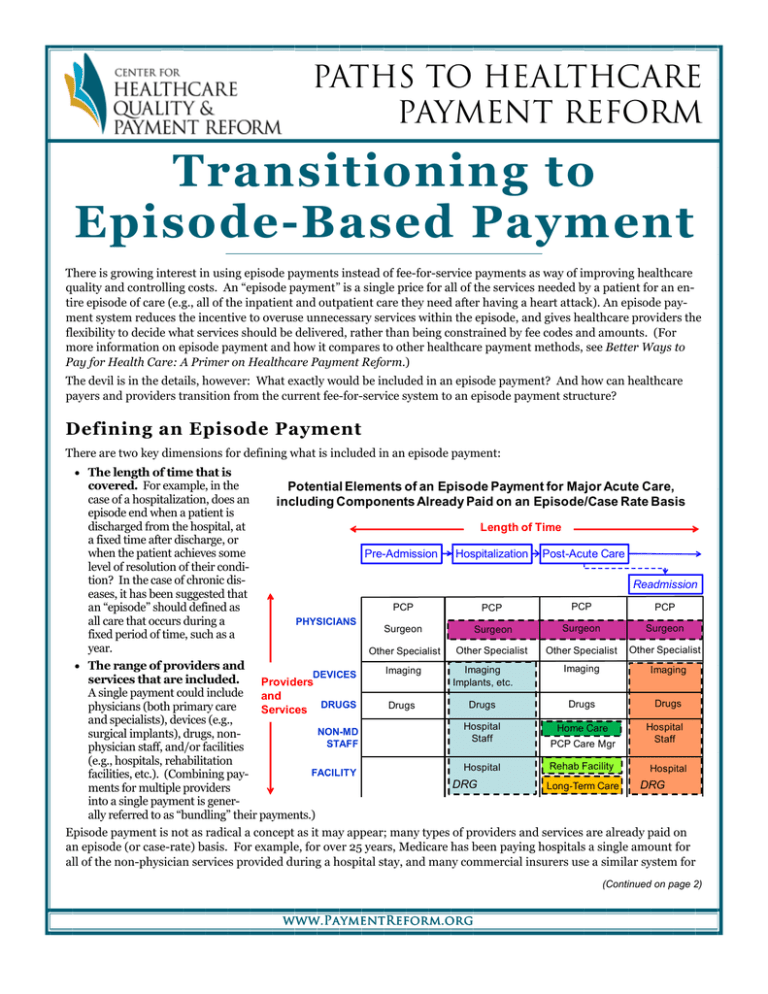Transitioning to Episode-Based Payment PATHS TO HEALTHCARE PAYMENT REFORM
advertisement

PATHS TO HEALTHCARE PAYMENT REFORM Transitioning to Episode-Based Payment There is growing interest in using episode payments instead of fee-for-service payments as way of improving healthcare quality and controlling costs. An “episode payment” is a single price for all of the services needed by a patient for an entire episode of care (e.g., all of the inpatient and outpatient care they need after having a heart attack). An episode payment system reduces the incentive to overuse unnecessary services within the episode, and gives healthcare providers the flexibility to decide what services should be delivered, rather than being constrained by fee codes and amounts. (For more information on episode payment and how it compares to other healthcare payment methods, see Better Ways to Pay for Health Care: A Primer on Healthcare Payment Reform.) The devil is in the details, however: What exactly would be included in an episode payment? And how can healthcare payers and providers transition from the current fee-for-service system to an episode payment structure? Defining an Episode Payment There are two key dimensions for defining what is included in an episode payment: • The length of time that is covered. For example, in the Potential Elements of an Episode Payment for Major Acute Care, case of a hospitalization, does an including Components Already Paid on an Episode/Case Rate Basis episode end when a patient is discharged from the hospital, at Length of Time a fixed time after discharge, or when the patient achieves some Pre-Admission Hospitalization Post-Acute Care level of resolution of their condition? In the case of chronic disReadmission eases, it has been suggested that PCP PCP PCP PCP an “episode” should defined as all care that occurs during a PHYSICIANS Surgeon Surgeon Surgeon Surgeon fixed period of time, such as a year. Other Specialist Other Specialist Other Specialist Other Specialist • The range of providers and Imaging Imaging Imaging Imaging DEVICES services that are included. Providers Implants, etc. A single payment could include and Drugs Drugs Drugs Drugs physicians (both primary care Services DRUGS and specialists), devices (e.g., Hospital Hospital Home Care NON-MD surgical implants), drugs, nonStaff Staff STAFF PCP Care Mgr physician staff, and/or facilities (e.g., hospitals, rehabilitation Rehab Facility Hospital Hospital FACILITY facilities, etc.). (Combining payDRG DRG Long-Term Care ments for multiple providers into a single payment is generally referred to as “bundling” their payments.) Episode payment is not as radical a concept as it may appear; many types of providers and services are already paid on an episode (or case-rate) basis. For example, for over 25 years, Medicare has been paying hospitals a single amount for all of the non-physician services provided during a hospital stay, and many commercial insurers use a similar system for (Continued on page 2) www.PaymentReform.org Page 2 Transitioning to Episode-Based Payment (Continued from page 1) payment. Surgeons and obstetricians are typically paid a single case rate for all of the care associated with a single episode of surgery or labor and delivery. Medicare now pays for home care, rehabilitation, and long-term care on an episode basis. What does not routinely happen today is for the services of different providers to be “bundled” together into a single episode payment, even if all of those services are integral parts of a patient’s total episode of care. This leads to (at least) two different types of problems: • There is no financial incentive for multiple providers involved in the same portion of a patient’s overall episode of care to coordinate their activities in a value-maximizing way. For example, even though the hospital is responsible for paying for the costs of devices, drugs, staffing, etc. using its episode of care payment (the DRG), it is the physicians who fundamentally control what drugs are prescribed, what devices are used, etc., and there is no financial incentive in the physicians’ payments to encourage them to help manage those costs. • There is a financial incentive for each provider to shift costs onto other providers involved in separately-paid portions of the patient’s overall episode of care. For example, a hospital may benefit by discharging patients earlier and having care that could have otherwise been provided during the hospital stay covered through home care or even through a later hospital readmission. Transitional Steps Toward Full Episode Payments Because bundling requires independent providers to coordinate, trying to create a single payment for all providers and services in an entire episode represents a big step to take all at once. But one doesn’t need to include a full episode or all providers in an episode payment in order to achieve some of the benefits of episode payment, just as DRGs were successful even though they covered only the non-physician costs within the hospital portion of an episode. Transitional steps, each beneficial in their own right, could include: • Paying each provider a single amount for each phase of an episode of care. For example, all physicians, not just surgeons and obstetricians, could be paid a single fee for care during and immediately following a hospitalization. • Including a “warranty” in each provider’s episode payment. For example, hospitals could be paid a single amount for both the initial hospital stay and any readmissions related to the original diagnosis, rather than receiving an additional payment when the patient has to be readmitted. • Allowing gain-sharing between providers in a particular phase of an episode of care. For example, if a hospital could reduce unnecessary expenditures on drugs or devices through a coordinated effort with its physicians, it could share a portion of the savings with the physicians. • Bundling payments for all providers in a particular phase of an episode of care. If each provider is already receiving a provider-specific episode payment and has a gain-sharing arrangement with other providers involved in the same portion of the episode, it is a relatively easy step to then make a single “bundled” payment to those providers. • Combining payments for different providers in different phases of an episode, e.g., paying a single fee for both inpatient and post-acute care. In addition, it isn’t necessary to have every type of condition or patient paid on an episode basis. Some types of conditions could be paid on an episode basis, while others could continue to be paid on a fee-for-service basis. Which transitional steps to take depends on the specific goals to be achieved. For example, if the goal is to better coordinate decisions among multiple providers, then gain-sharing or bundled payments for those providers could be implemented. On the other hand, if the goal is to control over-utilization of certain kinds of services, then a single payment for all services controlled by a particular provider could be used. In any of these transitional steps, severity adjustment for payment amounts will be critical, i.e., the payment level for a particular type of episode should be higher if the patient has more complex needs. Fortunately, there are now far better severity adjustment systems available than in the past; in addition to MS-DRGs and APR-DRGs for hospital episodes, there are systems such as Potentially Preventable ReadmissionsTM and Clinical Risk GroupsTM developed by 3M, the severity adjustment models and definitions of Potentially Avoidable Complications developed by PROMETHEUS, Inc., etc. Good severity adjustment systems will help protect patients from receiving too little care and protect providers from receiving payments that are too small. 320 Ft. Duquesne Blvd., Suite 20-J Pittsburgh, PA 15222 VOICE: (412) 803-3650 FAX: (412) 803-3651 EMAIL: Info@CHQPR.ORG www.PaymentReform.org




